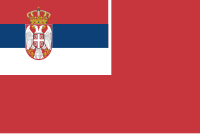Serbian Navy
| River Flotilla | |
|---|---|
 
River Flotilla Unit Emblem and Flag
|
|
| Active | March 30, 1833 – current |
| Country | Serbia |
| Branch | Serbian Army |
| Type | Brown-water navy |
| Role | Control of inland waterways |
| Size | 1,000 sailors and 400 support personnel 16 ships and boats |
| Part of | Serbian Armed Forces |
| Headquarters | Novi Sad |
| Anniversaries | August 6 |
| Engagements |
First Balkan War Second Balkan War World War I World War II Croatian War of Independence |
| Commanders | |
| River Flotilla Commander | Commodore Andrija Andrić |
| Insignia | |
| Naval Ensign |  |
The Serbian River Flotilla ([Речна Флотила / Rečna Flotila] error: {{lang-xx}}: text has italic markup (help)) is the specific unit of the Serbian Land Forces with the task of keeping an optimum operational regime of sailing and of protection of Serbian interests in interior sailing corridors. The area consists of rivers and canals with a total length of 1,626 km. The unit is composed of the Command ship Kozara, river minesweepers and assault loading boats. The command of River Flotilla is based in Novi Sad, as is most of its units, except for those based in Belgrade and Šabac.
The Šajkaši flotilla of the last Serbian Despot, Pavle Bakić, fought against the Ottomans.
On March 30, 1833, the Serbia set sail. It was built at Dubravica shipyard by Greek Nikola Kefala by order of Knjaz Miloš (TT information: length 24m, breadth 7m, draughts 3,5m, carrying capacity 250t). In April 1840, the Knjaz Mihailo was constructed in Brza Palanka (TT information: length 65m, breadth 7,5m, draughts 4,5m, armament of ship was 12 cannons).
Serbia received its first true warship, the patrol boat Jadar, on August 6, 1915. It was built in Čukarica. The ship was armed and used for mine laying on the Sava river. On the Danube, during World War I, the armed tug Stig protected Russian convoys coming to the port of Prahovo against Austro-Hungarian aircraft until October 1915, when Stig had to be scuttled after the Bulgarian invasion.
...
Wikipedia
